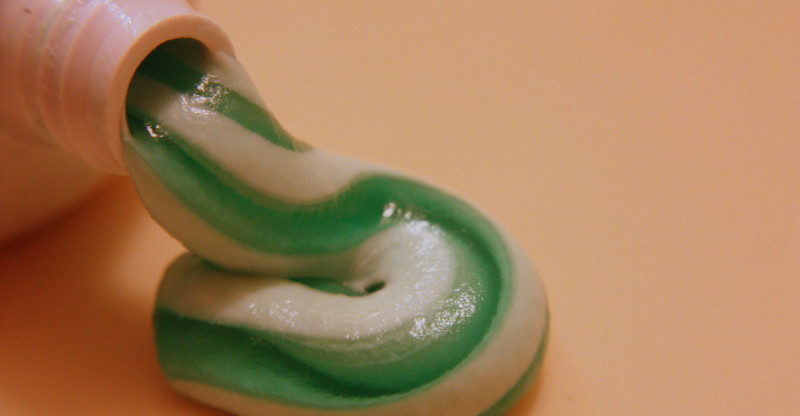By Amanda Just, MS, and Griffin Cole, DDS, NMD from CHD’s Partner: International Academy of Oral Medicine and Toxicology (IAOMT)
Fluoride is not essential for human growth and development, and it has been identified as one of 12 industrial chemicals known to cause developmental neurotoxicity in humans. Concerns have been raised about potential associations between fluoride and health risks such as cancer, bone fractures, musculoskeletal effects, reproductive and developmental effects, neurotoxicity and neurobehavioral effects, and effects on other organ systems.
RELATED STORY:
To complicate matters, concerns have also been raised about children’s use of toothpaste, much of which contains fluoride. Earlier this year, the Centers for Disease Control and Prevention (CDC) and pediatricians both warned about children using too much toothpaste, resulting in ingestion of fluoride.
Risks of Fluoride to Children
Specific health risks to children from fluoride have been recognized and include bone cancer (osteosarcoma), IQ loss, attention-deficit/hyperactivity disorder (ADHD), and many other adverse outcomes. Exposure to excess fluoride in children is also known to result in dental fluorosis, which has been identified as a first sign of fluoride toxicity.
“According to data from the Centers for Disease Control and Prevention (CDC) released in 2010, 41% of children aged 12-15 exhibit fluorosis to some degree.”
Dental fluorosis can range from very mild to severe and is a condition in which the teeth enamel becomes irreversibly damaged and the teeth become permanently discolored, displaying a white or brown mottling pattern and forming brittle teeth that break and stain easily. According to data from the Centers for Disease Control and Prevention (CDC) released in 2010, 41% of children aged 12-15 exhibit fluorosis to some degree.
However, a new analysis of the most recently available government data found that 65% of American children now have some degree of dental fluorosis. This data and more information are included in a March 2019 report published in the Journal of Dental Research – Clinical & Transactional Research.
RELATED STORY:
Additionally, in extreme cases, fluoride toxicity from dental products can be fatal. For example, in 1974 a three-year old Brooklyn boy died due to a fluoride overdose from dental gel. A reporter for the New York Times wrote of the incident: “According to a Nassau County toxicologist, Dr. Jesse Bidanset, William ingested 45 cubic centimeters of 2 percent stannous fluoride solution, triple an amount sufficient to have been fatal.”
Background on Fluoride in Toothpaste and Required Labeling
Fluoride was not widely used for any dental purposes prior to the mid-1940’s. In 1945, it was first used for artificial water fluoridation in spite of warnings about its potential hazards. Meanwhile, fluoridated toothpastes were introduced and their increase in the market occurred in the late 1960s and early 1970s. By the 1980s, the majority of commercially available toothpastes in industrialized countries contained fluoride. Other fluoridated dental products were likewise promoted for commercial use in recent decades.
Fluoride added to toothpaste can be in the form of sodium fluoride (NaF), sodium monofluorophosphate (Na2FPO3), stannous fluoride (tin fluoride, SnF2), or a variety of amines. Toothpaste used at home generally contains between 850 to 1,500 ppm fluoride, while prophy paste used in the office during a dental cleaning generally contains 4,000 to 20,000 ppm fluoride. Brushing with fluoridated toothpaste has been reported to raise fluoride concentration in saliva by 100 to 1,000 times, with effects lasting one to two hours.
The U.S. FDA requires specific wording for the labeling of “anticaries drug products” sold over-the-counter, such as toothpaste and mouthwash, including strict warnings for children. The labeling is designated by the form of the product, as well as by the fluoride concentration. Warnings also are divided by age groups (i.e. two years and older, under six, 12 years and older, etc.). Some warnings apply to all products, (with suggestions for bold copy and fill in the blanks) such as the following:
- For all fluoride dentifrice (gel, paste, and powder) products. “Keep out of reach of children under 6 years of age. [highlighted in bold type] If more than used for brushing is accidentally swallowed, get medical help or contact a Poison Control Center right away.”
- For all fluoride rinse and preventive treatment gel products. “Keep out of reach of children. [highlighted in bold type] If more than used for “(select appropriate word: “brushing” or “rinsing”) ” is accidentally swallowed, get medical help or contact a Poison Control Center right away.”
Dangers to Children from Toothpaste
A research article published in 2014 raised significant concerns about this labeling. The authors established that over 90% of the products they evaluated listed the FDA warning for use only by children over the age of two on the back of the tube of toothpaste and in small font.
Similar circumstances were reported about warnings from the American Dental Association (ADA). The researchers documented that all of the toothpastes with approval or acceptance by the ADA placed the ADA warning (that children should use a pea-sized amount of toothpaste and be supervised by an adult to minimize swallowing) on the back of the tube in small font.
“Misleading marketing strategies are regularly used in selling children’s toothpaste as if it is a food product, while warnings regarding overconsumption among youth are minimized.”
Marketing strategies were further identified as promoting toothpaste as if it were a food product, with the researchers acknowledging this tactic could dangerously result in children swallowing the product. More specifically, the researchers stated:
“Aggressive marketing strategies targeting children were identified: every toothpaste in this sample displayed at least 1 children’s animated character, 50% had at least 1 picture of a food item, 92.3% stated they were flavored and 26.9% depicted a full swirl of toothpaste, directly contradicting dentist recommendations for young children…Misleading marketing strategies are regularly used in selling children’s toothpaste as if it is a food product, while warnings regarding overconsumption among youth are minimized.”
Indeed, research suggests that toothpaste significantly contributes to daily fluoride intake in children, partly due to swallowing toothpaste. Some research has even suggested that, due to swallowing, toothpaste can account for greater amounts of fluoride intake in children than water. In light of the significant fluoride exposures in children from toothpaste and other sources, researchers at the University of Illinois at Chicago explained that their findings raised “questions about the continued need for fluoridation in the U.S. municipal water supply.”
Other Dental Products Also Contain Fluoride
Mouth rinses (and mouthwash) can also contribute to overall fluoride exposures. Fluoridated dental floss is yet another product that contributes to overall fluoride exposures. Fluoride gels and foams can also be used at the dentist office and sometimes even at home. Many consumers use these products in combination on a regular basis, and thus, these multiple routes of fluoride exposure are even more relevant when estimating overall intakes.
In addition to these over-the-counter dental products, some of the materials used at the dental office can result in even higher fluoride exposure levels. Dental “restorative” materials, which are used to fill cavities, are used on children, and consideration of the fluoride levels in these materials is crucial. Many of the options for filling materials contain fluoride, including all glass ionomer cements, all resin-modified glass ionomer cements, all giomers, all polyacid-modified composites (compomers), certain types of composites, and certain types of dental mercury amalgams. Fluoride-containing glass ionomer cements, resin-modified glass ionomer cements, and polyacid-modified composite resin (compomer) cements are also used in orthodontic band cements.
RELATED STORY:
Silver diamine fluoride is now another fluoride dentifrice. This is a relatively new dental procedure that was FDA approved in 2014 for treating tooth sensitivity, but not dental caries. Concerns have been raised about risks of silver diamine fluoride, which can permanently stain teeth black.
Reduce Fluoride Exposures for Your Children
Since fluoride is being added to all of these products, as well as the majority of American community water supplies and other consumer items, parents are tasked with the responsibility of overseeing their children’s fluoride intakes. Given the current levels of exposure, parents should reduce and work toward eliminating avoidable sources of fluoride, including water fluoridation, fluoride-containing dental materials, and other fluoridated products, as means to promote their children’s health and safety.
For more information, learn the Fluoride Facts from the International Academy of Oral Medicine and Toxicology (IAOMT). To read more specifically about fluoride and dental products, including references to scientific research, visit https://files.iaomt.org/wp-content/uploads/IAOMT-Comprehensive-Review-on-Fluoride-in-Dental-Products.pdf.
*Article originally appeared at Children’s Health Defense.












